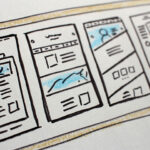By Hebe Vessuri

Image: Ky0n Cheng.
Attached as they are to an editorial model of the printed world, journals fear that the open access process that has emerged with the Internet will mean their end. Why does this happen in view of the fact that one might think that an institution that finances a scientific journal should seek maximum impact, i.e., try to disseminate it as broadly as possible so it can be widely used and cited? Since being digital and open is precisely a proven way to achieve these objectives, why should the financier of a scientific journal be concerned about the possible universal opening of its access, even if it means entering another dynamic, losing their (often very few) real subscribers?
Often, open access is not considered as such, but the emphasis is placed on the ways in which it can affect existing dissemination tools, acquired habits, and the distribution of actors and institutions. The subject is often discussed, regarding journals and articles, as canonical forms of scholarly communication that are at risk because of the disruptive appearance of open access, which is perceived as an “uncontrolled” and therefore “threatening” form of communication. In such cases, it is expected that open access will conform to the forms, rules, and routines of journals and articles. As always, when a newness arises in history, the new is visualized as something that should behave like the old, the familiar, the comfortable.
The current transition to the digital age is as fundamental as that produced by the press in the fifteenth century. Consequently, and reasonably, we should expect changes that profoundly affect our societies, our cultural values, our ways of thinking, and our methods of collectively managing memory, and do so profoundly and intensely as the press did. The objects produced, the cultural values attached to them and the relationships that people have with these objects change drastically. The relations between documents also change and, ultimately, society itself reflects these transformations in its own economic and political structure.
Regarding scientific journals, we see the emergence of new forms of publication, such as mega-journals, that confuse many people, because in fact they do not look or behave like journals. Other media, such as Research Ideas & Outcomes (RIO), publish different products of the research cycle, including project proposals, data, methods, workflows, software, etc. The growing visibility of the “publishing platform” concept points to deep transformations of the contexts in which dialogues occur more often.
Undoubtedly, journals currently have many key and important functions in the production, validation, preservation, and dissemination of knowledge. However, given the prospect of profound, though still unpredictable, transformations, what can we think about the future of scholarly communication? What ways can we predict for it? Should we try to keep journals, even though they may not exist in a century? Or the articles, although they represent little more than the unavoidable interruption at all times of a conversation carried out by a technology committed to batch production? Obviously, no answer is satisfactory when it seeks to optimize the production of knowledge in the future (even in the near future).
Wouldn’t it be more useful to try to examine the future by focusing on these functions instead of communication formats that are currently in place, with their survival strategies? One could, for example, preserve and even optimize them. It would be possible to imagine how to finance them, associating them with the types of objects and processes that best meet the needs of the “Great Dialogue” in knowledge production. This would allow us to critically examine the current situation: the journal format is not free from limitations, flaws, and serious issues, including their associated business models. It is possible that the article, as a frozen moment in the scientific discourse, soon appears as ill-conceived and desperately outdated. The task at hand is to build on the digital reality of documents and their management, and create the digital objects, tools, and processes necessary to increase the dialogue between researchers.
Note
1. Note based on the reading of “Crystals of Knowledge Production. An Intercontinental Conversation about Open Science and the Humanities” by STERN, N., GUÉDON, J.C. and JENSEN T.W. published in Nordic Perspectives on Open Science.
Reference
STERN, N., GUÉDON, J.C. and JENSEN T.W. Crystals of Knowledge Production. An Intercontinental Conversation about Open Science and the Humanities. Nordic Perspectives on Open Science [online]. 2015, vol. 1, ISSN: 2464-1839 [viewed 20 August 2018]. DOI: 10.7557/11.3619. Available from: http://dx.doi.org/10.7557/11.3619
About Hebe Vessuri
Hebe Vessuri is an emeritus researcher at the Center for Social Science Studies at the Institute of Scientific Research (IVIC) in Venezuela, a visiting researcher at the Center for the Research of Environmental Geography (CIGA) at the Universidad Nacional Autónoma de México and a collaborating researcher at the Institute of Human and Social Sciences in Patagonia, CENPAT-CONICET, Argentina. Vessuri helped found graduate programs in Science and Technology Studies (STS) in Venezuela and Brazil, and the Latin American Association of Social Studies in Science and Technology (ESOCITE). She chaired the Science, Technology and Development Committee of the Latin American Council of Social Sciences (CLACSO) and the Rectory of the University of the United Nations. She was vice-president of the International Union of Anthropological and Ethnological Sciences (IUAES) and participated in a significant way in the UNESCO Ethics Committee on Science, the International Council on Risk Governance (IRGC), the International Human Development Program (IHDP) and the International Council of Social Sciences (ISSC). In 2017, she received the Bernal Prize from the Society for Social Studies of Science (4S).
This post was written for the panel “The political and social impact of journals and the research they communicate” of the SciELO 20 Years Conference.
Translated from the original in Spanish by Lilian Nassi-Calò
Como citar este post [ISO 690/2010]:

















Read the comment in spanish, by Roy D. Meléndez DVM, MSc.:
https://blog.scielo.org/es/2018/08/20/el-paper-y-las-revistas-cientificas-tienen-futuro/#comment-41804